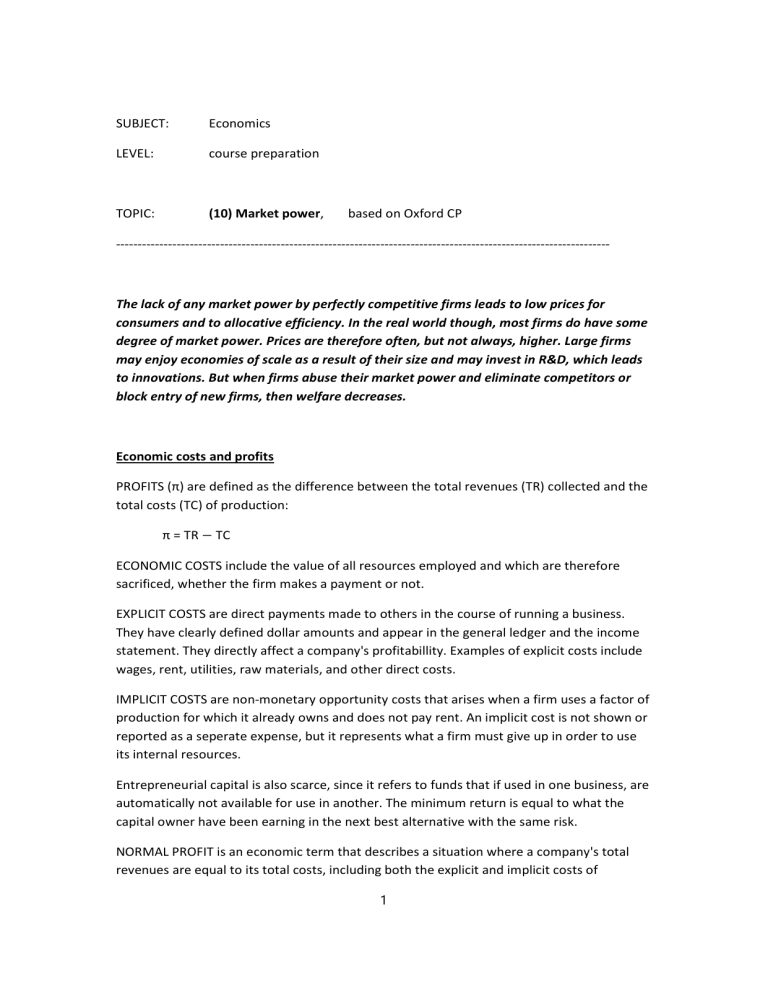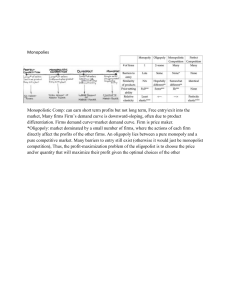
SUBJECT: Economics LEVEL: course preparation TOPIC: (10) Market power, based on Oxford CP ------------------------------------------------------------------------------------------------------------------ The lack of any market power by perfectly competitive firms leads to low prices for consumers and to allocative efficiency. In the real world though, most firms do have some degree of market power. Prices are therefore often, but not always, higher. Large firms may enjoy economies of scale as a result of their size and may invest in R&D, which leads to innovations. But when firms abuse their market power and eliminate competitors or block entry of new firms, then welfare decreases. Economic costs and profits PROFITS (π) are defined as the difference between the total revenues (TR) collected and the total costs (TC) of production: π = TR − TC ECONOMIC COSTS include the value of all resources employed and which are therefore sacrificed, whether the firm makes a payment or not. EXPLICIT COSTS are direct payments made to others in the course of running a business. They have clearly defined dollar amounts and appear in the general ledger and the income statement. They directly affect a company's profitabillity. Examples of explicit costs include wages, rent, utilities, raw materials, and other direct costs. IMPLICIT COSTS are non-monetary opportunity costs that arises when a firm uses a factor of production for which it already owns and does not pay rent. An implicit cost is not shown or reported as a seperate expense, but it represents what a firm must give up in order to use its internal resources. Entrepreneurial capital is also scarce, since it refers to funds that if used in one business, are automatically not available for use in another. The minimum return is equal to what the capital owner have been earning in the next best alternative with the same risk. NORMAL PROFIT is an economic term that describes a situation where a company's total revenues are equal to its total costs, including both the explicit and implicit costs of 1 production. It means that the company is earning enough to cover its opportunity cost of uses its resources effectively and maintaing a competitive edge in its industry. Normal profit is also known as the break-even point or zero economic profit. SUPERNORMAL PROFITS are all the excess profits a firm makes above the minimum return necessary to keep a firm in business. ECONOMIC LOSS is the situation when a firm delivers not enough income to equal all its economic costs including minimum return necesary to cover the cost of capital resources. How much output should a firm choose to produce in order to maximize prots? As long as the additional revenue from producing and selling one more unit is bigger than the additional cost incurred to produce it, the firm should keep on producing more and more units per period because its profits will be increasing. Profits will be maximized when, for the last unit produced, MR = MC. Products and markets Amidst others, we can distinguish the following two broad types of products: A. HOMOGENEOUS PRODUCTS are products that consumers consider perfect substitutes (identical). B. DIFFERENTIATED PRODUCTS are products consumers consider close but not perfect substitutes. We can distinct the following types of markets: A. PERFECTLY COMPETITIVE markets have very many small firms, selling a homogeneous product and there’s nothing to prevent entry of new firms into the market. B. MONOPOLISTICALLY COMPETITIVE MARKETS have many small firms and there’s nothing to prevent entry into the market of new firms; but these firms sell a differentiated product. C. OLIGOPOLISTIC MARKETS have few interdependent firms and there are barriers preventing new firms from entering. The product may be either homogeneous or differentiated. D. In a MONOPOLY market there is one firm dominating the market and there are barriers preventing new firms from entering. 2 ENTRY BARRIERS are any kind of obstacles that deter new companies from entering a given market. Firms try to erect barriers to limit competition and to be able to keep any supernormal profits. Common entry barriers include: a. a limited number of government licences (ex. television station) b. a patent protection regulations (ex. pharmaceuticals) c. strong brand identity and customer loyalty, heavy advertising d. technology challenges and start-up costs. Perfectly competitive markets Firms in perfect competition have no market power. This means there are so many firms operating, and each is so small compared to the market, that any one of them cannot affect the price that market forces determine - each of these firms is a price-taker. If the typical firm starts to make supernormal profits, there is an incentive for others to enter the market. They can enter it because, in perfect competition, there are no entry barriers. On the other hand, if the typical firm was making an economic loss, then it would exit the market. In the short run, the typical firm can make supernormal profits, normal economic profits, or even economic losses. In the long run, though, the typical firm will necessarily make zero economic profits; that is, only normal profits. Entry and exit will ensure this outcome. A NATURAL MONOPOLY is a monopoly in an industry in which high infrastructural costs and other barriers to entry relative to the size of the market give the largest supplier in an industry, often the first supplier in a market, an overwhelming advantage over potential competitors. ECONOMIES OF SCALE are cost advantages companies experience when production becomes efficient, as costs can be spread over aa larger amount of goods. The CONCENTRATION RATIO is used to quantify market concentration and are based on companies' market shares in a given industry. It is the proportion of total market sales accounted by the n largest firms, where n is usually, but not necessarily, the four largest firms in terms of sales. Interdependence exists if the outcome of any action of one firm depends on the reaction of 3 rival firms. Interdependence in oligopolistic markets implies greater uncertainty and the risk of a price war when firms compete by successively cutting price. COLLUSION exists when firms agree to fix prices and engage in other anti-competitive behaviour. This is generally illegal as it undermines the most basic benefit of free markets, that of competition. -------------------------------------------------------------------------------------------------- 4



